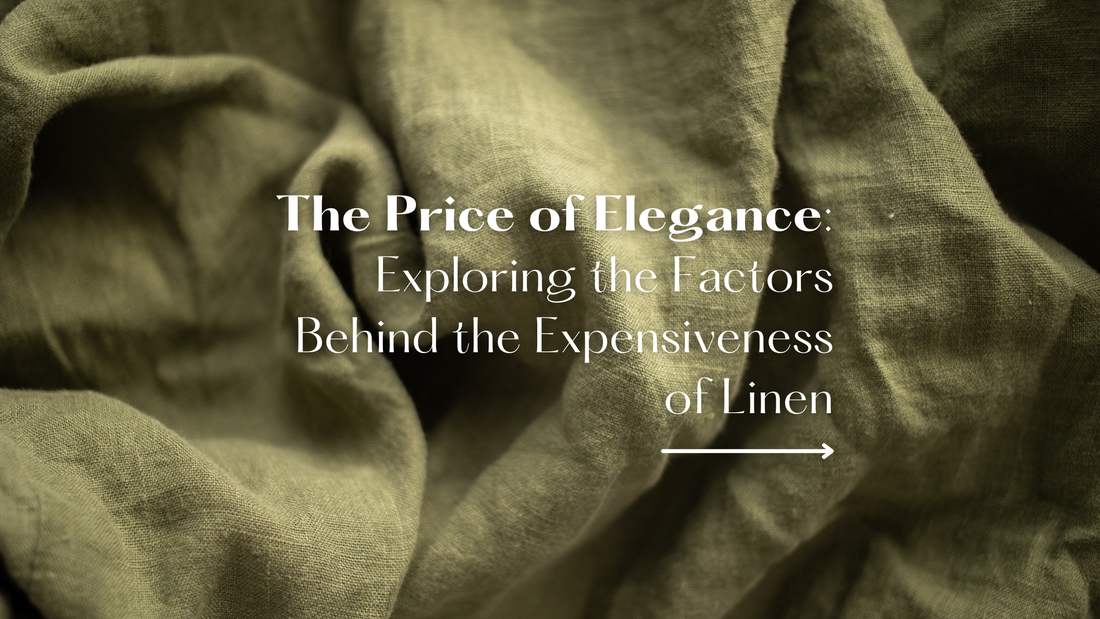Introduction:
Linen, known for its exceptional quality and timeless appeal, is often associated with a higher price tag compared to other fabrics. In this blog, we delve into the reasons why linen is considered expensive and explore the factors that contribute to its premium value. From the intricate production process to the unique characteristics of linen, we aim to shed light on the fascinating world of linen and unravel the mystery behind its elevated cost.
1. Labor-Intensive Cultivation and Production:

Linen's journey begins with the cultivation of flax plants, which require meticulous care and attention throughout their growth cycle. From planting and harvesting to retting and extracting fibers, the process is labor-intensive, demanding skilled craftsmanship at every step. The manual handling of flax fibers and the delicate nature of the material contribute to the higher cost of linen compared to other fabrics. Harvesting flax is time-consuming and laborious.
From seed to harvest, the time for flax to be ready is about 90 days. The plant must be uprooted and not simply cut in order to maximize the length of the fiber that can be harvested. Once harvested, the process of extracting the flax fiber from the stalk of the plant involves a laborious 3 step process of retting (soaking the stalks to soften them), scutching (separating the woody stalk from the inner fiber) and finally hackling (separating the long fibers from shorter ones).
Hence, making the cultivation of flax plants a labor intensive and time consuming process which reflects in higher prices of linen fabric.
2. Limited Availability and Production Volume:

Compared to other fabrics like cotton or synthetic materials, linen is produced in relatively smaller quantities. Flax cultivation is limited to specific regions with suitable climate conditions, reducing the availability of flax fibers. Additionally, the production of linen requires specialized equipment and expertise, which further limits the production volume. The combination of limited availability and lower production volume contributes to the higher price of linen.
3. High-Quality Raw Materials:

Linen's luxurious reputation is owed to its premium raw material - flax. Flax fibers possess unique properties that make them ideal for creating high-quality linen fabric. Flax plants require specific soil conditions and careful cultivation, resulting in superior fibers with excellent strength, durability, and breathability. The meticulous selection and processing of high-quality flax fibers contribute to the higher cost of linen as compared to fabrics made from lesser quality materials.
4. Complex Manufacturing and Finishing Processes:
Transforming flax fibers into linen fabric involves intricate manufacturing and finishing processes. From spinning and weaving to bleaching and dyeing, each step requires attention to detail and skilled craftsmanship. Linen fabrics often undergo additional processes, such as stonewashing or garment dyeing, to enhance their aesthetic appeal. These complex manufacturing and finishing processes involve specialized machinery, expert knowledge, and increased production time, all of which add to the cost of linen.
5. Exceptional Characteristics and Longevity:

Linen is highly regarded for its exceptional characteristics that set it apart from other fabrics. Its breathability, moisture-wicking properties, and natural luster make it a desirable choice for clothing and home textiles. Linen's durability and longevity ensure that garments made from this fabric can withstand the test of time. The superior quality and long-lasting nature of linen justify its higher price, as it offers value in terms of longevity and reduced need for frequent replacement.
Conclusion:
While the higher price of linen may initially raise eyebrows, understanding the factors behind its expensiveness unveils the craftsmanship, quality, and uniqueness that define this fabric. The labor-intensive cultivation and production, limited availability, high-quality raw materials, complex manufacturing processes, and exceptional characteristics all contribute to the elevated cost of linen. Embracing linen is an investment in timeless elegance and sustainability, as its durability and longevity outweigh the initial expense. By appreciating the craftsmanship and artistry involved in creating linen, we can better comprehend the value it brings to our wardrobes and homes, making every linen purchase a worthwhile investment.
Checkout some of the finest quality garments made from European flax linen at https://linin.co/.

